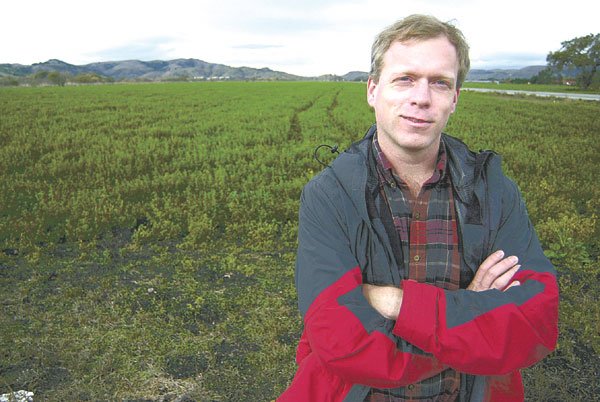Local environmental activist Brian Schmidt is dedicated to
protecting open space, including Coyote Valley north of Morgan
Hill
San Jose – Brian Schmidt wears his politics on his business card (Committee for Green Foothills), his feet (Birkenstocks) and the bumper of his Toyota Prius (a sticker reading, “Al Qaeda hates this car”).
Schmidt is virtually unknown here outside of government meetings, but may be South County’s most vigorous environmental advocate. An unassuming, clean cut Palo Alto attorney, he’s prone to rail against the role of development interests in local politics, eager to take on the county’s most powerful residents, and a tireless defender of every last blade of grass in South County.
“I’m fearful that urban sprawl is going to extend from San Jose all the way to Gilroy,” Schmidt said recently of the housing and business developments sprouting up and down South Valley. “Are we using Los Angeles as our model? It’s hard to see the big picture when you’re developing at a nickel and dime rate.”
But with a new city the size of Morgan Hill and Gilroy combined proposed for Coyote Valley, development is coming in significantly larger denominations. And for all the talk of smart growth surrounding the Coyote Valley development plan, Schmidt expects the region to grow in whichever way suits the developers and home builders financing San Jose’s intensive planning process.
“The Coyote Valley task force mostly seems to be a vehicle for facilitating development interests,” he said. “We’re losing an opportunity to merge a good idea of the future that combines the hi-tech aspects of our culture and open space.”
Environmental advocates say that building what amounts to a new city between Morgan Hill and San Jose will cause untold environmental havoc. In addition to wiping out the largest rural area left on the Santa Clara Valley floor, the project could destroy critical wildlife habitat and migration corridors, wipe out acres of farmland and further clog county roads and highways.
Every time the task force meets, Schmidt gets up and implores them to cast a more critical eye on the project and then laments the lack of debate and probing questions that mark most Coyote Valley meetings. In the two and half years he’s been with the Committee for Green Foothills, he’s become a professional community member, weighing in on issues ranging from the trail plan at Stanford University to the Williamson Act, from Coyote Valley to environmental degradation at entrepreneur John Fry’s Morgan Hill golf course.
“Brian’s about as effective an advocate as anyone in his position can be,” said Barton Hechtman, a land use attorney with a view of property rights far different that Schmidt’s. “I think he has a difficult message for decision-makers to accept because Brian’s message is quite frequently that property rights need to yield to the greater needs of the public for open space.”
Schmidt’s passion for the environment grew up with him outside Rochester, N.Y. He was raised in a suburban development amid acres of second-growth forest that grew out of abandoned farm land.
I had a chance to experience nature because there was plenty of it left in that area,” he said. “It was readily accessible to a child on foot. I would spend hours in the woods.”
Schmidt, 38, came to California in 1996 to attend law school at Stanford University. Before joining Committee he worked for the Sierra Club Legal Defense Fund. Schmidt said he was drawn by the urgency of the environmental cause, the sense that his work is never done.
“We often feel like our victories are temporary and our defeats our permanent.” he said. “If you stop a bad project one year, they’ll come back the next with another bad project. It’s not that we don’t believe in property rights. We’re just trying to find a balance between public and private rights.”
That conflict has provided plenty of drama over the last year as county politicians and planners have struggled to find a way to take away the Williamson Act property tax beak from hundreds of landowners.
For decades, Santa Clara County planners approved illegitimate subdivisions and issued illegal building permits to landowners getting a tax break under the Williamson Act tax, but not farming their property as the law requires. In ending that practice, the county left hundreds of landowners unable to build on land they intended to use as home sites.
The task of finding a solution to that problem was considered so difficult and politically dicey that the county ignored it for years. But in 2005, a committee that included Schmidt found an answer.
To put the county in the state’s good graces, about 1,000 unfarmed parcels will be evicted from the act and lose the tax break. At the same time, landowners who want to build but don’t want to wait 10 years for their Williamson contract to expire will be allowed to transfer to the state’s Open Space Easement Act, which also provides a tax savings but has far fewer restrictions.
The solution has pleased nearly everyone except Schmidt, who sees it as a sop to residents who are angry about losing a tax break they never should have received.
To make his point, Schmidt wrote “A Land Use Parable” about Jane Forthright, who follows the rules of Williamson and waits 10 years to build a legal house, and John Sneaky, who uses the loophole to build a McMansion in the middle of valuable open space.
“In an attempt to respond to political pressure from land owners under Williamson Act contracts,” he said, “[Supervisors are] going to use the Open Space Easement Act as a loophole and not get any open space protection.”
And no Williamson Act property owner has infuriated Schmidt more than Fry, who built a new professional-caliber golf course in Morgan Hill without environmental clearance.
As part of a deal with the city of Morgan Hill to get the proper permits after the fact, Fry promised to withdraw the course from the Williamson Act. When he didn’t, Schmidt petitioned the county district attorney to launch a criminal tax fraud investigation.
Morgan Hill has since evicted the land from the act, and the California Department of Conservation, which enforces the act, is investigating Fry’s use of the land.
Schmidt believes Fry, the founder of Fry’s Electronics, received special treatment from Morgan Hill officials because of his wealth and status. One more example of South County being paved over with asphalt and money.
“It’s not solely a matter of power and wealth,” Schmidt said, “but I don’t think someone who illegally built an extension on their house would get the same treatment as Fry, who built an illegal golf course.”















